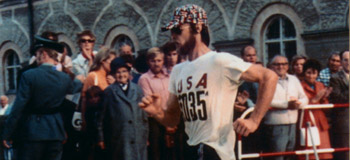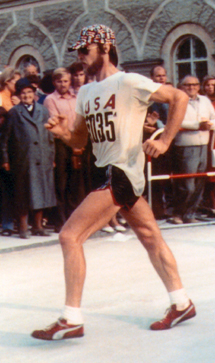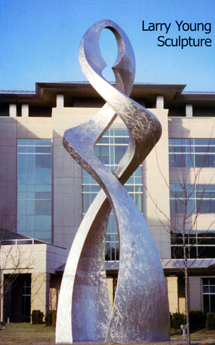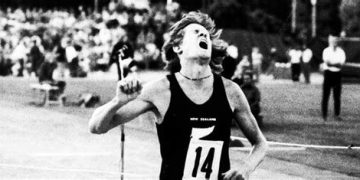
Larry Young is the confluence of creative energy and athletic discipline. The only U.S. athlete to medal in the Olympic race walk, Young did it twice, in 1968 and 1972, over 50,000 meters, or 50k. The 50k race walk, which is 31.6 miles for those who still do not understand metric distances, is the longest and most arduous event on the Olympic schedule. Like cross country skiers,
race walkers push themselves to exhaustion, over 3 1/2-4 hours, while having to follow the arcane technique of their event. Someone once equated race walking to the act of whispering while running for several hours.
Young was great at the distance, in in 1972, added the 20k to his Olympic racing regimen. The man now makes his living as a well respected sculpture, (see Larry Young Sculpture). I remember Kenny Moore noting that he could write papers on his 30 mile runs. For myself, I worked on my paintings on weekly 20 milers, and would then go into the studio and paint all day. I was always curious if Mr. Young had that creative experience?
In researching Mr. Young, I also found out that the guy race walked 100 miles in 18:07:12. Now that is amazing! Larry Young is in the USATF Hall of Fame.
 the dance, a sculpture by Larry Young
the dance, a sculpture by Larry Young

Larry Young is a unique person in U.S. Olympic history. He is the only
person to win Olympic medals in the race walks. The race walks, which
got their start in the 18th and 19th century pedestrian races, are
walked over 20 kilometers and 50 kilometers.
 Larry Young, Munich 1972, photo courtesy of USA Track & Field
Larry Young, Munich 1972, photo courtesy of USA Track & Field
The race walk requires the endurance of a cross country skier and the
agility of a hurdler. One must not bend one’s knee with this modified
walking style, and holding one’s style while walking 31 plus miles, to
near exhaustion, is exceedingly difficult. The athlete who succeeds at
this event is unique: Larry Young was such a unique athlete.
Larry Young got his start in track & field running the mile and half
mile. While in high school, at all comers meets in upstate New York,
Larry tried the race walk, learning the walk and doing pretty well,
improving to just under 8 minutes for the mile. During this time, Larry Young met
USATF Hall of Famer and Olympian Ron Laird, who convinced Young to walk
indoors in California.
In two famous meets, the LA Invite and the San Diego Invite, Young
finished dead last in loaded fields. Just about to throw in the towel,
Olympian Laird convinced Larry Young to run a handicapped race (where,
based on one’s skill, runners or walkers run a certain part of the
distance, so the best athlete would walk, say, ten miles and the next
best, 9 miles 1,200 yards, and perhaps the newest competitor might walk
seven miles). Well, finally, Larry Young had some success at the 10 mile
distance, finishing fourth.
In 1966, Larry Young walked his first 50k, that’s 31.6 miles, the
longest distance on the Olympic schedule. In 1967, Larry Young won his
first major event, the Pan Am Games, walking 50k in 4:26, an American
record at the time!
In 1968, in Mexico City, Larry Young listened to his own counsel, and
started out very slow, not going out with the leaders. In the heat,
humidity and altitude, Young started passing walkers about 20k, and by
35k, was within striking distance of the leaders. What kept him focused
over the last 15k? As he passed fellow walkers, he noticed how exhausted
they were, and unfocused, and he knew that his plan had worked! Larry
Young, in extraordinary conditions, walked 4:31:55, to take the Olympic
bronze.
The next year, Larry took a scholarship at Columbia College in Columbia,
Missouri, to study art, with his focus on sculpture. Young trained in
earnest in 1969, and again took gold medal at 50k in the Pan Am Games in
1971, defending his gold from 1967.
In 1972, Larry Young walked his fastest 50,000 meters of his career, in
4:00:46, still, 38 years later, the ten best EVER in U.S. history. While
Young walked through 1977-79, his dream of another Olympics were
shattered when the boycott on the Moscow Olympics was announced. After
that, Larry Young retired to focus on his large sculptures.
Who will be the next Larry Young? If you want to learn more about the
race walk, please send us an email to larry@runningnetwork.com and we
will help you find a race walking club or coach. (A great web site is www.racewalking.com).
 Hope, by Larry Young
Hope, by Larry Young
Special thanks to Mr. Larry Young, (www.youngsculpture.com) for the use of the photos showcasing his sculpture. Special thanks to USA Track & Field (www.usatf.org) for the use of the hall of fame photo.

Author

Larry Eder has had a 52-year involvement in the sport of athletics. Larry has experienced the sport as an athlete, coach, magazine publisher, and now, journalist and blogger. His first article, on Don Bowden, America's first sub-4 minute miler, was published in RW in 1983. Larry has published several magazines on athletics, from American Athletics to the U.S. version of Spikes magazine. He currently manages the content and marketing development of the RunningNetwork, The Shoe Addicts, and RunBlogRun. Of RunBlogRun, his daily pilgrimage with the sport, Larry says: "I have to admit, I love traveling to far away meets, writing about the sport I love, and the athletes I respect, for my readers at runblogrun.com, the most of anything I have ever done, except, maybe running itself." Also does some updates for BBC Sports at key events, which he truly enjoys. Theme song: Greg Allman, " I'm no Angel."
View all posts




















